Multi-Underwater Gliders Coverage Path Planning Based on Ant Colony Optimization
Abstract
1. Introduction
- (1)
- A detection coverage model for single period of the UG is proposed;
- (2)
- Redesign the feasible region of the ants adapt to the motion constraints of the UGs;
- (3)
- Reconstruct the transition probability, pheromone update rule and fitness function of ant colony algorithm to increase coverage efficiency and reduce coverage costs.
2. Motion Process of UG
- (a). Setting gliding parameters, including gliding angle, heading angle, depth, and then preparing to dive.
- (a–b). Reducing buoyancy, gliding down at glide angle and adjusting the wing angle. Influenced by the wings, the UG moves forward simultaneously during the diving process.
- (b). Adjusting buoyancy and preparing to float.
- (b–c). Increasing buoyancy, gliding upwards at glide angle and adjusting the wings to the opposite direction. Influenced by the wings, the UG moves forward simultaneously during the floating process.
- (c). Surfacing and reporting location.
3. Detection Coverage Modeling
3.1. Sonar Detection Probability
3.2. Detection Radius Map
3.3. Detection Model of One-Period Gliding
4. MGCPP-ACO
4.1. Optimization Objective
4.2. Ant Colony Optimization
4.2.1. Collaboration Strategy
4.2.2. Feasible Region Constraints
4.2.3. State Transition Rule
4.2.4. Escape from Local Optimum
4.2.5. Fitness Function
4.2.6. Pheromone Update Rule
4.3. Pseudocode of MGCPP-ACO
| Algorithm 1: MGCPP-ACO |
| 01: Model underwater environments and initialize pheromone amount |
| 02: Determine the initial positions and heading of ants and parameters of ACO |
| 03: while termination rule is not met do |
| 04: Mark all ants as alive and place them at starting points |
| 05: for g = 1 to |
| 06: for p = 1 to P |
| 07: for i = 1 to m |
| 08: if is alive |
| 09: Implement state transition rule to select next waypoint |
| 10: if feasible region is NULL |
| 11: Escape from local optimum |
| 12: end if |
| 13: else |
| 14: The fitness of anti = -Inf |
| 15: end if |
| 16: moves to next waypoint |
| 17: if collisions with the seabed |
| 18: Mark as dead |
| 19: end if |
| 20: end for |
| 21: end for |
| 22: Evaluate paths of all alive ants; |
| 23: end for |
| 24: Implement pheromone update rule to update pheromone |
| 25: end while |
| 26: Returns the final path of the iteration |
5. Simulation Experiment and Result Analysis
5.1. Simulation Environment
5.2. Analysis of MGCPP-ACO Algorithm
5.3. Performance Comparison
5.3.1. Scanline Covering (SCAN) Algorithm
5.3.2. Comparison and Analysis
6. Conclusions
Author Contributions
Funding
Data Availability Statement
Conflicts of Interest
References
- Wu, H.; Niu, W.; Wang, S.; Yan, S. An analysis method and a compensation strategy of motion accuracy for UG considering uncertain current. Ocean. Eng. 2021, 226, 108877. [Google Scholar] [CrossRef]
- Takeshita, Y.; Jones, B.D.; Johnson, K.S.; Chavez, F.P.; Rudnick, D.L.; Blum, M.; Conner, K.; Jensen, S.; Long, J.S.; Maughan, T. Accurate pH and O2 measurements from spray UGs. J. Atmos. Ocean. Technol. 2021, 38, 181–195. [Google Scholar] [CrossRef]
- Zhang, F.; Ennasr, O.; Litchman, E.; Tan, X. Autonomous sampling of water columns using gliding robotic fish: Algorithms and harmful-algae-sampling experiments. IEEE Syst. J. 2015, 10, 1271–1281. [Google Scholar] [CrossRef]
- Zhou, M.; Bachmayer, R.; de Young, B. Working towards seafloor and underwater iceberg mapping with a Slocum glider. In Proceedings of the 2014 IEEE/OES Autonomous Underwater Vehicles (AUV), Oxford, MS, USA, 6–9 October 2014; pp. 1–5. [Google Scholar]
- Wang, C.; Yuan, M. Application study of a new UG with single vector hydrophone for target direction finding. IEEE Access 2021, 9, 34156–34164. [Google Scholar] [CrossRef]
- Guastella, D.C.; Cantelli, L.; Giammello, G.; Melita, C.D.; Spatino, G.; Muscato, G. Complete coverage path planning for aerial vehicle flocks deployed in outdoor environments. Comput. Electr. Eng. 2019, 75, 189–201. [Google Scholar] [CrossRef]
- Perez-Imaz, H.I.; Rezeck, P.A.; Macharet, D.G.; Campos, M.F. Multi-robot 3D coverage path planning for First Responders teams. In Proceedings of the 2016 IEEE International Conference on Automation Science and Engineering (CASE), Fort Worth, TX, USA, 21–25 August 2016; pp. 1374–1379. [Google Scholar]
- Adaldo, A.; Mansouri, S.S.; Kanellakis, C.; Dimarogonas, D.V.; Johansson, K.H.; Nikolakopoulos, G. Cooperative coverage for surveillance of 3D structures. In Proceedings of the 2017 IEEE/RSJ International Conference on Intelligent Robots and Systems (IROS), Vancouver, BC, Canada, 24–28 September 2017; pp. 1838–1845. [Google Scholar]
- Han, G.; Zhou, Z.; Zhang, T.; Wang, H.; Liu, L.; Peng, Y.; Guizani, M. Ant-colony-based complete-coverage path-planning algorithm for UGs in ocean areas with thermoclines. IEEE Trans. Veh. Technol. 2020, 69, 8959–8971. [Google Scholar] [CrossRef]
- Kapoutsis, A.C.; Chatzichristofis, S.A.; Kosmatopoulos, E.B. DARP: Divide areas algorithm for optimal multi-robot coverage path planning. J. Intell. Robot. Syst. 2017, 86, 663–680. [Google Scholar] [CrossRef]
- Nedjati, A.; Izbirak, G.; Vizvari, B.; Arkat, J. Complete coverage path planning for a multi-UAV response system in post-earthquake assessment. Robotics 2016, 5, 26. [Google Scholar] [CrossRef]
- Huang, X.; Sun, M.; Zhou, H.; Liu, S. A multi-robot coverage path planning algorithm for the environment with multiple land cover types. IEEE Access 2020, 8, 198101–198117. [Google Scholar] [CrossRef]
- Glegg, S.A.L.; Olivieri, M.P.; Coulson, R.K.; Smith, S.M. A passive sonar system based on an autonomous underwater vehicle. IEEE J. Ocean. Eng. 2001, 26, 700–710. [Google Scholar] [CrossRef]
- Guo, Y.; Ai, R.; Chen, Y.; Qi, Y. Prediction of Passive Sonar Detection Range in Different Detection Probability. In Proceedings of the 2018 5th International Conference on Systems and Informatics (ICSAI), Nanjing, China, 10–12 November 2018; pp. 1289–1293. [Google Scholar]
- Rudnick, D.L.; Davis, R.E.; Eriksen, C.C.; Fratantoni, D.M.; Perry, M.J. Underwater gliders for ocean research. Mar. Technol. Soc. J. 2004, 38, 73–84. [Google Scholar] [CrossRef]
- Kepper, J.H.; Claus, B.C.; Kinsey, J.C. A navigation solution using a MEMS IMU, model-based dead-reckoning, and one-way-travel-time acoustic range measurements for autonomous underwater vehicles. IEEE J. Ocean. Eng. 2018, 44, 664–682. [Google Scholar] [CrossRef]
- Ajeil, F.H.; Ibraheem, I.K.; Azar, A.T.; Humaidi, A.J. Grid-based mobile robot path planning using aging-based ant colony optimization algorithm in static and dynamic environments. Sensors 2020, 20, 1880. [Google Scholar] [CrossRef]
- Kierstead, D.P.; DelBalzo, D.R. A genetic algorithm applied to planning search paths in complicated environments. Mil. Oper. Res. 2003, 8, 45–59. [Google Scholar] [CrossRef]
- Dorigo, M.; Birattari, M.; Stutzle, T. Ant colony optimization. IEEE Comput. Intell. Mag. 2006, 1, 28–39. [Google Scholar] [CrossRef]
- Stützle, T.; López-Ibáñez, M.; Pellegrini, P.; Maur, M.; de Oca, M.M.; Birattari, M.; Dorigo, M. Parameter adaptation in ant colony optimization. In Autonomous Search; Springer: Berlin/Heidelberg, Germany, 2011; pp. 191–215. [Google Scholar]
- Cabreira, T.M.; Brisolara, L.B.; Ferreira, P.R., Jr. Survey on coverage path planning with unmanned aerial vehicles. Drones 2019, 3, 4. [Google Scholar] [CrossRef]
- Artemenko, O.; Dominic, O.J.; Andryeyev, O.; Mitschele-Thiel, A. Energy-aware trajectory planning for the localization of mobile devices using an unmanned aerial vehicle. In Proceedings of the 2016 25th International Conference on Computer Communication and Networks (ICCCN), Waikoloa, HI, USA, 1–4 August 2016; pp. 1–9. [Google Scholar]
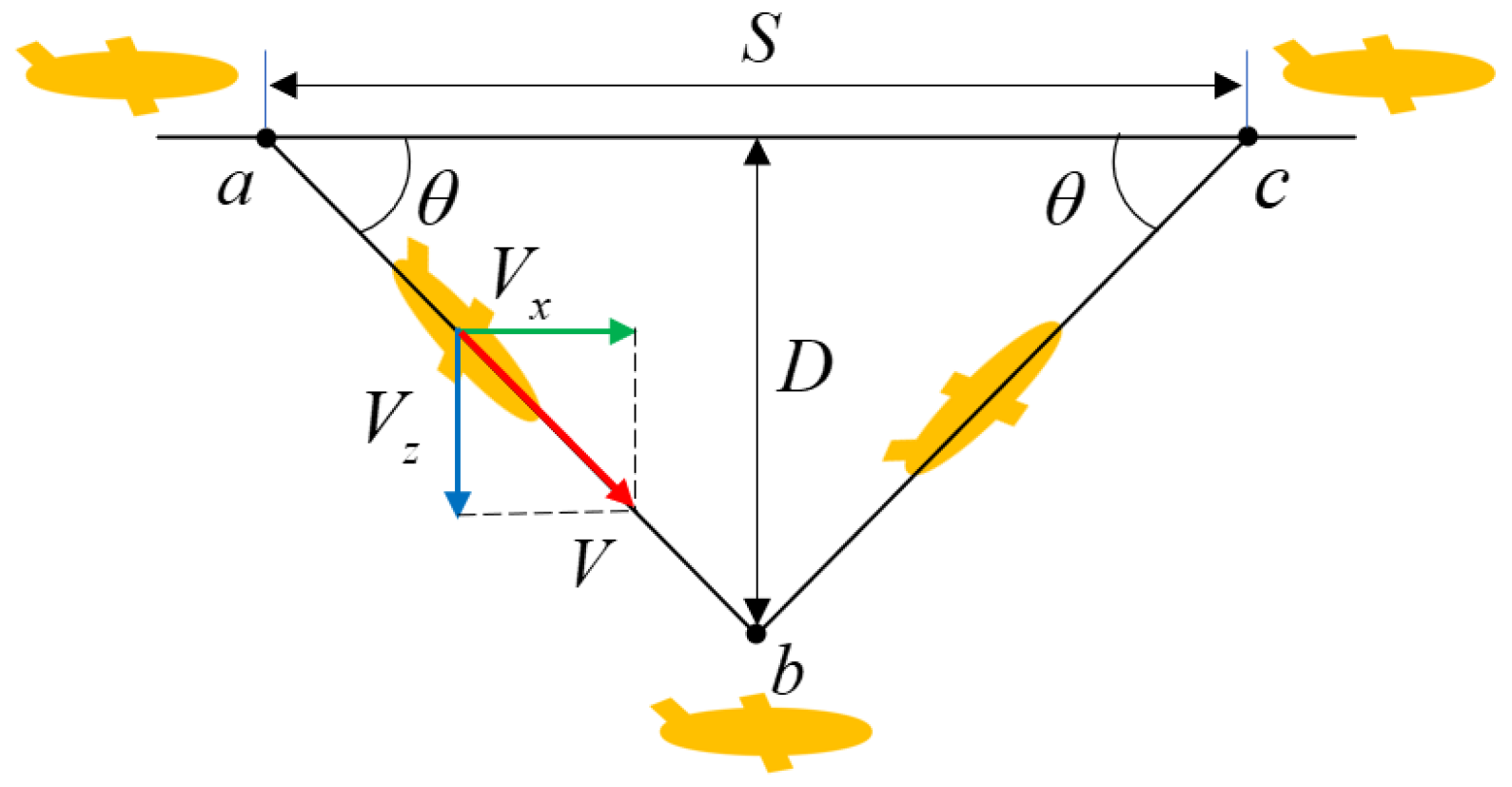
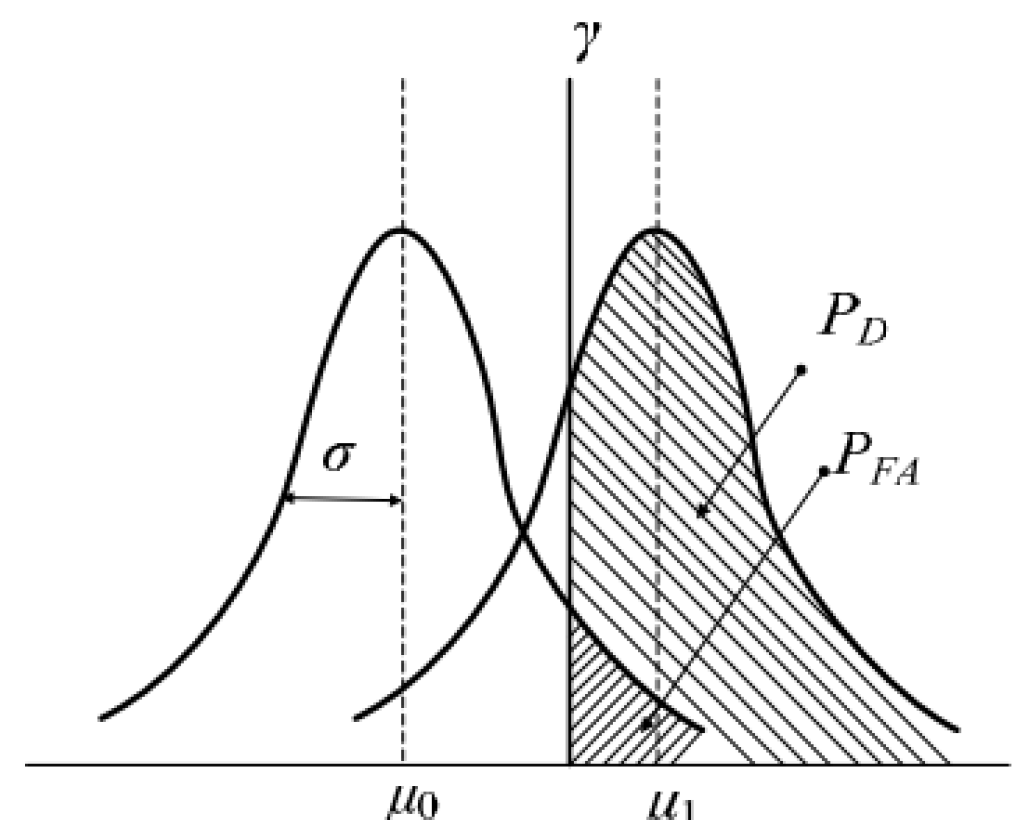
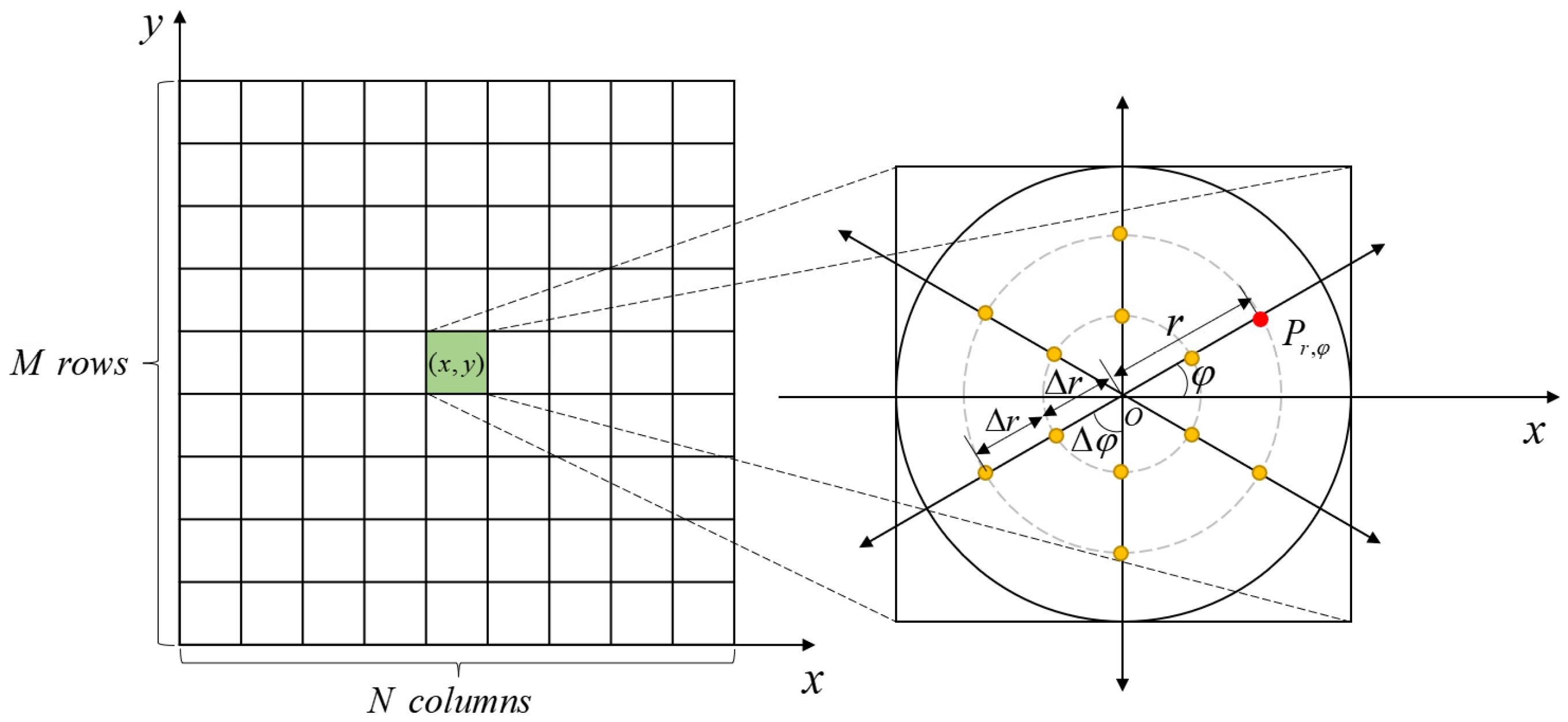
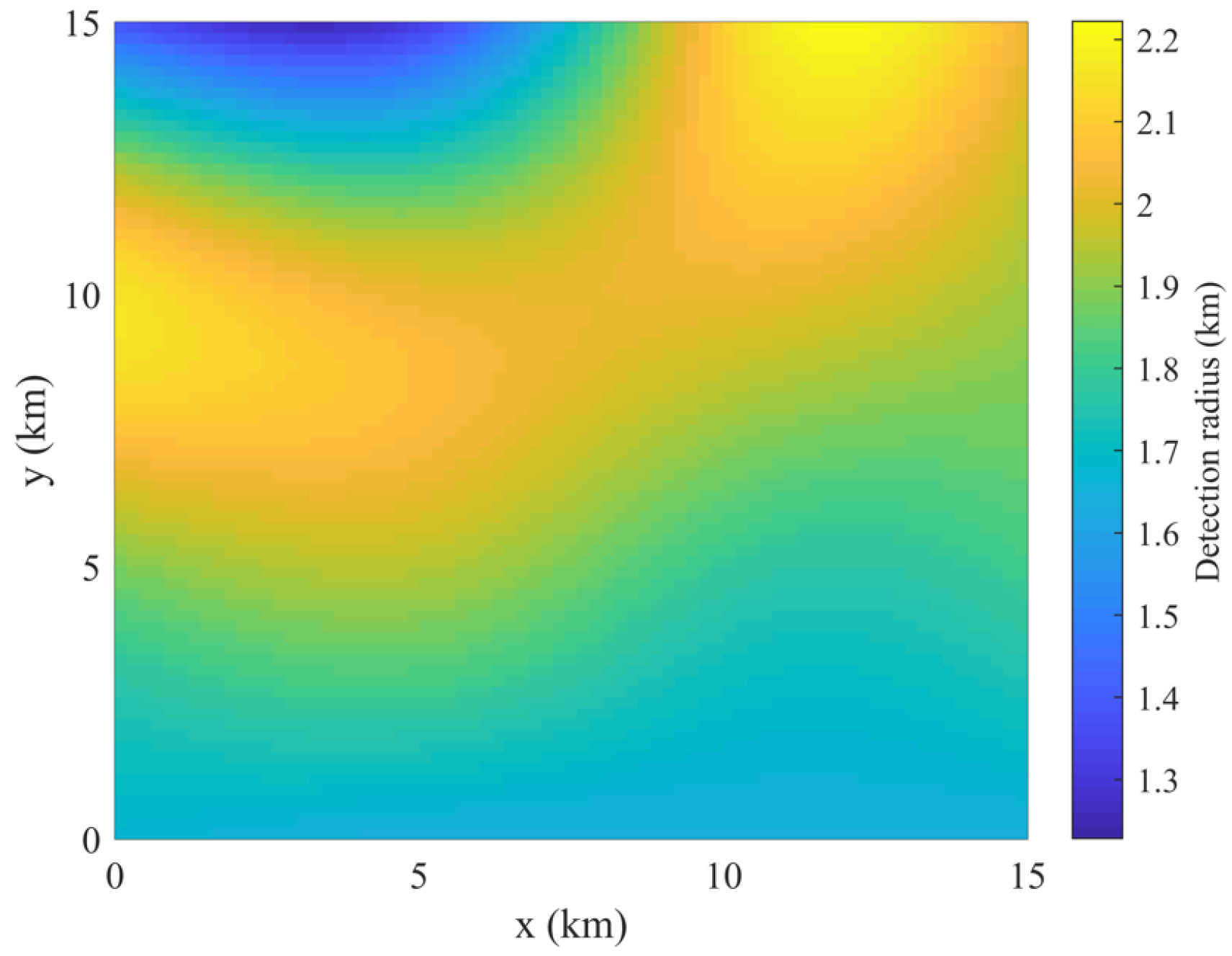



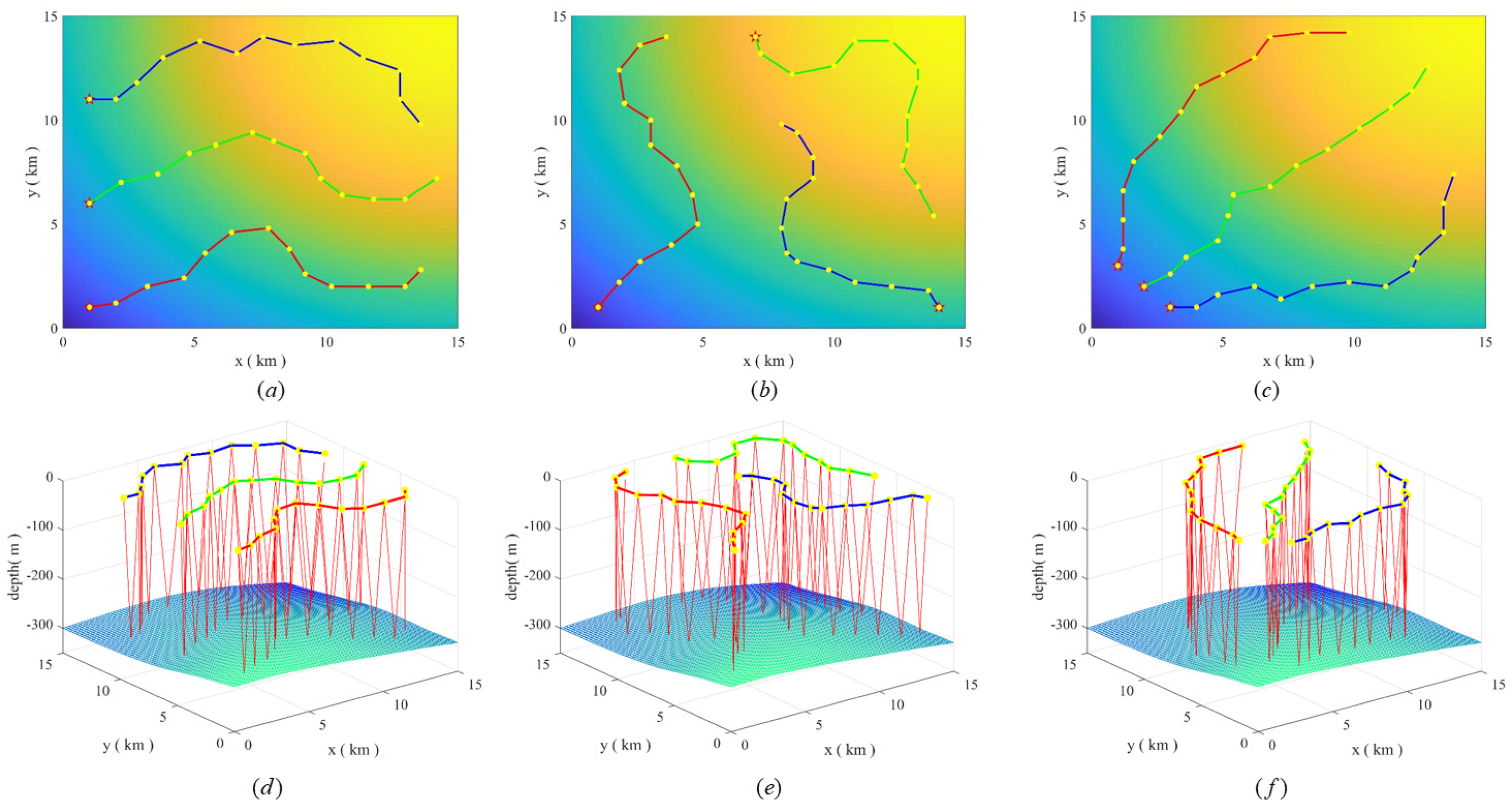
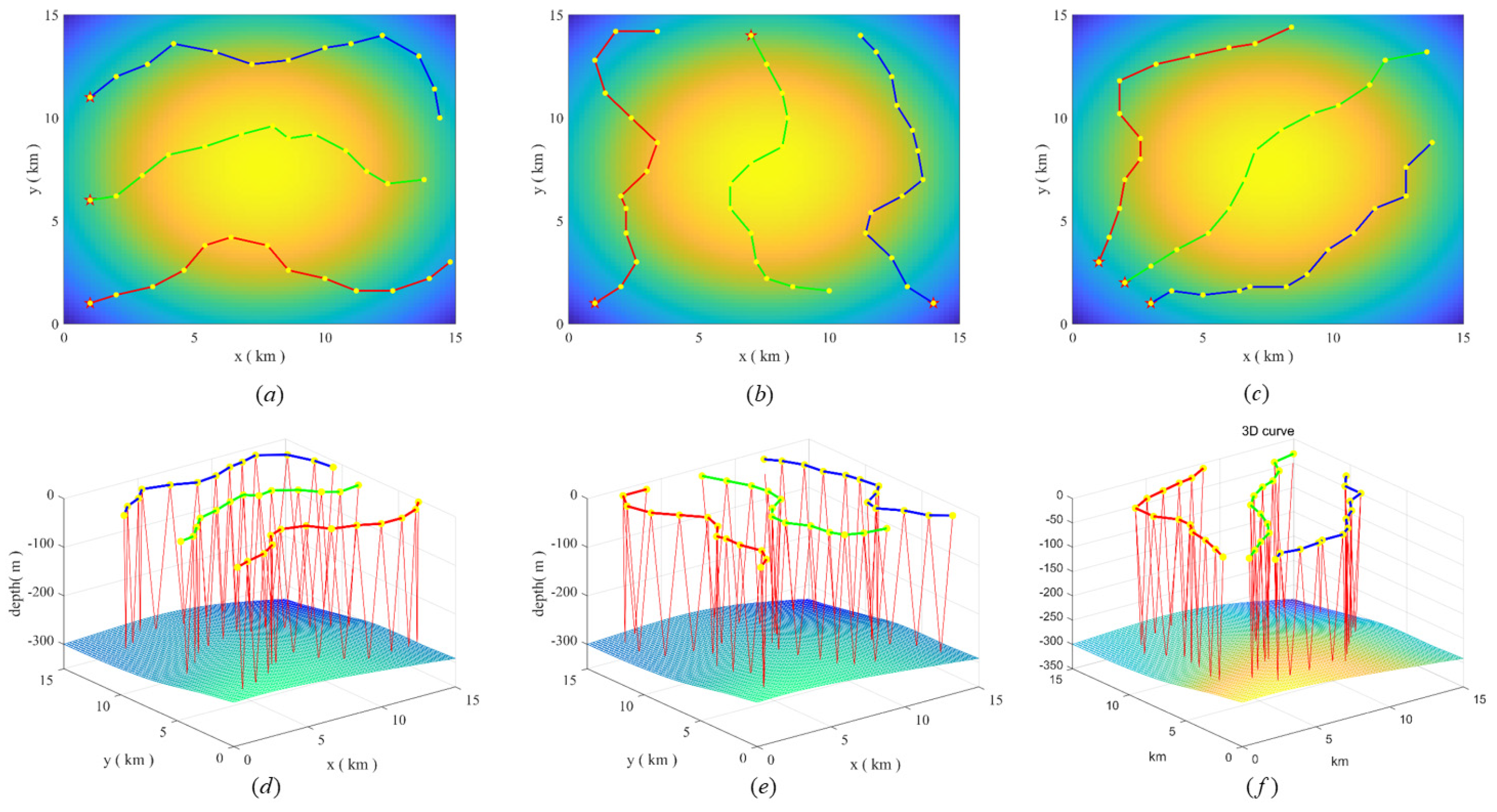
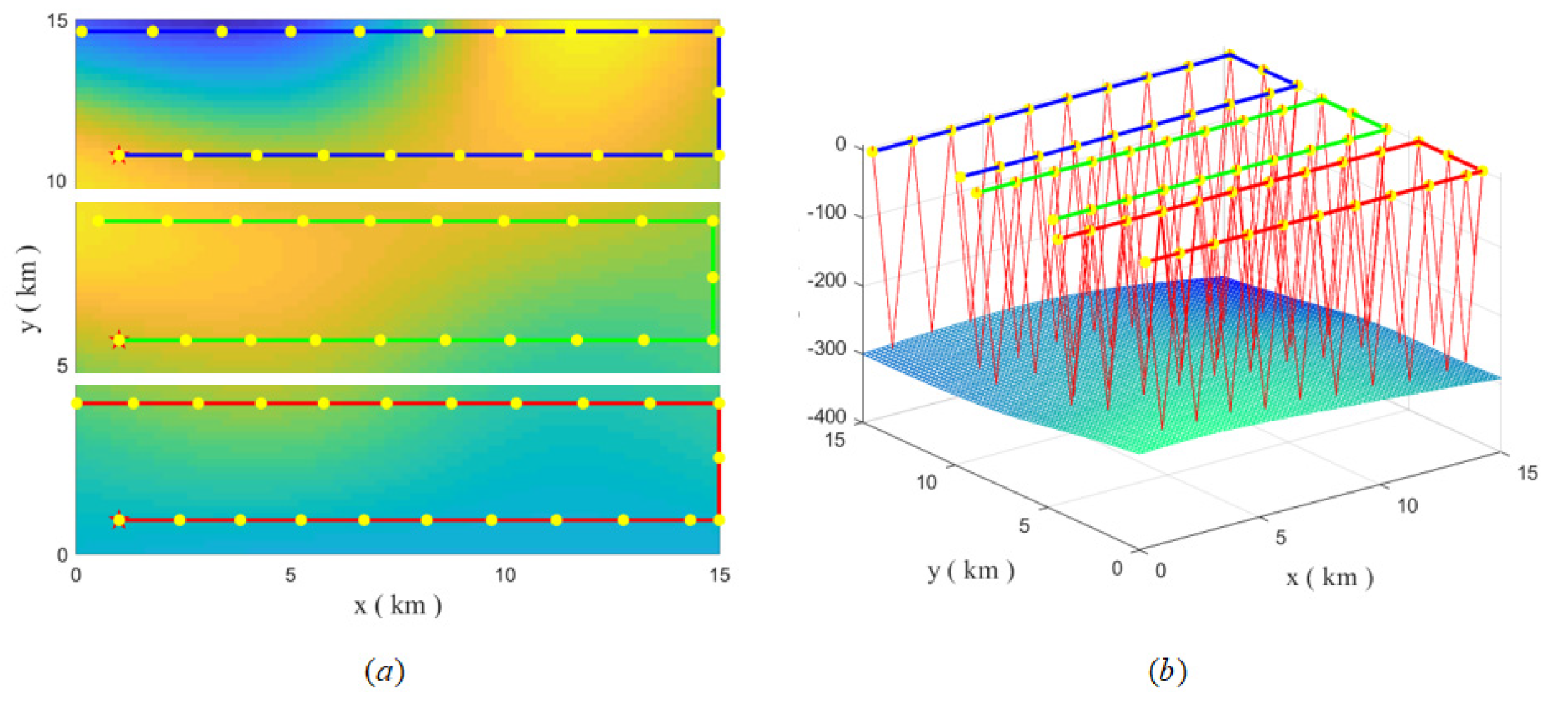
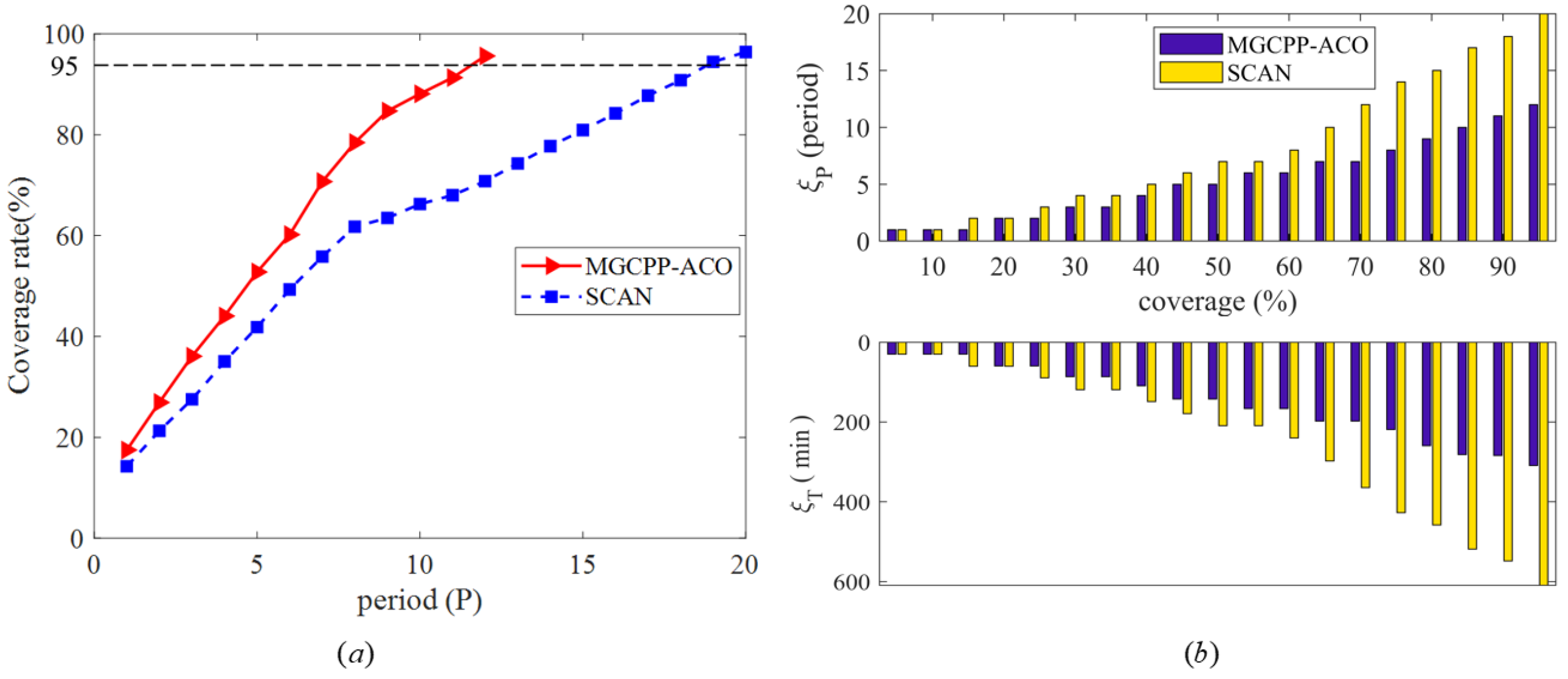
| UGs | Ants | |
|---|---|---|
| Mobile space | grid map | foraging space |
| Feasible Domain | a set of restricted outlet points | next walkable area |
| Behavior | from the water entry point to the next water outlet point | transfer next cell |
| Target | maximum coverage rate | find food |
| Parameters | Values | Description |
|---|---|---|
| 75 | number of rows in the grid map | |
| 75 | number of columns in the grid map | |
| 3 | number of UGs | |
| 100 | number of ant groups | |
| heading range | ||
| gliding depth range | ||
| gliding angle range | ||
| 0.8 | weight of the pheromone | |
| 0.8 | weight of the heuristic function | |
| 0.05 | evaporation coefficient | |
| 0.5 | fitness factor | |
| 100 | initial value of pheromone | |
| 10 | minimum value of pheromone | |
| 10,000 | maximum value of pheromone |
| Scenario Number | Fig | No. | Initial Coordinate (km) | Coverage Rate (%) | |||||
|---|---|---|---|---|---|---|---|---|---|
| 1 | Figure 7 | 1 | (1, 1) | (1, 6) | (1, 11) | 0 | 0 | 0 | 95.62 |
| 2 | (1, 1) | (7, 14) | (14, 1) | 90 | 270 | 90 | 91.33 | ||
| 3 | (1, 3) | (2, 2) | (3, 1) | 90 | 45 | 0 | 90.61 | ||
| 2 | Figure 8 | 4 | (1, 1) | (1, 6) | (1, 11) | 0 | 0 | 0 | 91.45 |
| 5 | (1, 1) | (7, 14) | (14, 1) | 90 | 270 | 90 | 84.64 | ||
| 6 | (1, 3) | (2, 2) | (3, 1) | 90 | 45 | 0 | 89.25 | ||
| 3 | Figure 9 | 7 | (1, 1) | (1, 6) | (1, 11) | 0 | 0 | 0 | 91.59 |
| 8 | (1, 1) | (7, 14) | (14, 1) | 90 | 270 | 90 | 87.17 | ||
| 9 | (1, 3) | (2, 2) | (3, 1) | 90 | 45 | 0 | 91.06 | ||
Publisher’s Note: MDPI stays neutral with regard to jurisdictional claims in published maps and institutional affiliations. |
© 2022 by the authors. Licensee MDPI, Basel, Switzerland. This article is an open access article distributed under the terms and conditions of the Creative Commons Attribution (CC BY) license (https://creativecommons.org/licenses/by/4.0/).
Share and Cite
Ji, H.; Hu, H.; Peng, X. Multi-Underwater Gliders Coverage Path Planning Based on Ant Colony Optimization. Electronics 2022, 11, 3021. https://doi.org/10.3390/electronics11193021
Ji H, Hu H, Peng X. Multi-Underwater Gliders Coverage Path Planning Based on Ant Colony Optimization. Electronics. 2022; 11(19):3021. https://doi.org/10.3390/electronics11193021
Chicago/Turabian StyleJi, Haijun, Hao Hu, and Xingguang Peng. 2022. "Multi-Underwater Gliders Coverage Path Planning Based on Ant Colony Optimization" Electronics 11, no. 19: 3021. https://doi.org/10.3390/electronics11193021
APA StyleJi, H., Hu, H., & Peng, X. (2022). Multi-Underwater Gliders Coverage Path Planning Based on Ant Colony Optimization. Electronics, 11(19), 3021. https://doi.org/10.3390/electronics11193021






